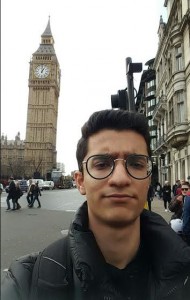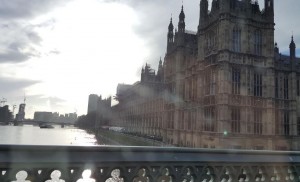Global Awareness:
Year 1: Having lived abroad, I have a fondness for traveling and meeting unique individuals. I suppose, however, that I need not go too far to meet extraordinary people. Ohio State is an enormous campus full of people from all walks of life. I will attempt to talk to them and listen to their stories. Additionally, I will try to study abroad. Currently, I am in the London Honors program and will be traveling to England in the winter of 2015. In my junior year, I will try to do something else which will let me go abroad.
Year 2: During Spring Break, I had the privilege of traveling to Williamsburg, Virginia through the Office of International Affairs. The group consisted of twenty international students and twenty domestic students. We spent four days touring places like Williamsburg, Jamestown, and Yorktown to see how the colonists lived and how the Revolutionary War was fought. The trip was interesting and mingling with the international students was wonderful. Aside from a slight language barrier, I feel that both groups had many things in common. It was healthy for all of us to come out of our comfort zones and converse with people we might have otherwise never approached.
I also became a member of the Indian American Association, and I attended the annual “Raise the Keffiyeh” event in January sponsored by the Students for Justice in Palestine. Both decisions proved to be phenomenal and culturally immersive.
My courses this year focused on globalization, the global economy, and our impact on the global environment. I am also finishing my fourth semester of Modern Standard Arabic.
Original Inquiry:
Year 1: As I am only a freshman, research is not a priority for me. But, nevertheless, I understand that when the time to pursue a research project is upon me, I should be prepared. I have begun preparing in a handful of ways. Firstly, I have tried understanding the ins and outs of OSU’s wonderful libraries, primarily, Thompson and Orton Hall. The libraries on campus are massive, beautiful, and resourceful. I will definitely be consulting them frequently for help and entertainment. Additionally, I will be taking challenging courses. For example, I have already fulfilled my math requirements for my major in Economics. Nevertheless, I still took Calculus II this semester. In the future, I will be taking numerous more classes centered on science and statistics to expand my ability to grasp difficult concepts, learn technical skills, and be a more holistic student and individual.
Year 2: Once again, I continued on with taking tough and challenging courses to broaden my mind and remain in the Honors College. Two particularly interesting courses I took were Statistics and Comparative Studies. Statistics has numerous practical applications. I now know how to use functions on my calculator I did not even know existed. This will help me greatly in the more advanced Economics courses I am taking next year. Comparative Studies, on the other hand, helped me grow by forcing me to develop my own voice and articulate my opinions in a coherent manner. This will help me beyond my courses.
For several courses, I also had to write concise academic research papers. To complete these, I had to utilize OSU’s online library database, which is a treasure trove of information. I will be using it for the remainder of my college career.
Academic Enrichment:
Year 1: The wonderful thing about the Honors & Scholars program is its emphasis on creativity and pursuing coursework which may be out of the norm. Regarding my major and academic pursuits, I have chosen to study Arabic. It is a beautiful language to write and speak, and I know it will come in handy should I travel to the Arab World. I will also be taking a fair amount of art and history courses. I love sketching, so I will try to take an art class that revolves around drafting and drawing. Or maybe I will do something a little different, such as a class on sculpting or ceramics. As for history, it has always been a fascinating subject for me. I will be taking history classes centered around immigration and development for my major in International Studies.
Year 2: Every course I took this year was fascinating and eye-opening in its own way. I particularly enjoyed the two Earth Science courses I took which discussed natural disasters and geology. When I was young, I loved reading encyclopedias related to paleontology or watching documentaries on dinosaurs and Earth history. So while some may find Earth Science to be a somewhat “dry” subject, I thoroughly enjoyed the two courses I took. The professors I had for my Political Science and Geography classes did a brilliant job of dictating the intricate interconnectedness that exists in our globalized, post-industrial world. I now view poverty, war, and the asymmetrical economic relationship between the First World and Third World through a new lens. And I will also be concluding my fourth and final semester of Arabic. Learning the language has been a rewarding journey. I have met good people in my classes and I know I will try to seek study abroad opportunities and careers in the Arab World. Next semester, I will be addressing my Agribusiness minor. I have enrolled in three agribusiness classes, so I should become quite familiar with the Ag campus! In place of Arabic next semester, I have decided to take an art class. As someone who enjoys sketching, I am looking forward to this course the most.
Leadership Development:
Year 1: At present, instances of my leadership are difficult for me to show. I guess what I can do to be a leader is to be a good student and individual. I will be respectful. I will not be involved in cases of academic misconduct. I will submit my assignments on time and keep my grades as high as I can keep them. Outside of the academic realm, I will be a leader by doing community service and by being a person of principle.
Year 2: Last semester, I became a M(ASC)OT for the College of Arts and Sciences. The program is in its first year, but it aims to have a lasting impact on the College in the long run. As a M(ASC)OT, I was involved in discussion, seminars, and events revolving around the College of Arts and Sciences, its future, and its most recent, underclassmen members.
Service Engagement:
Year 1: A year back when I lived in Illinois, I volunteered at a nursing home. Well, I decided to continue here in Columbus by applying for a volunteering position at Tridia Hospice. Helping the elderly is emotionally draining. But it is rewarding and a worthwhile pursuit. I may also choose to volunteer at the Nationwide Children’s Hospital. I have aided the elderly. Perhaps I should try my hand at helping those on the other end of the age spectrum.
Year 2: I secured an internship for the summer with the Center for Global Studies at Brien McMahon High School in Norwalk, Connecticut. It is a magnet school inside Brien McMahon which teaches member students either Japanese, Chinese, or Arabic, as well as literature and history revolving around the language they chose to learn. The Center also provides study abroad opportunities and hosts foreign exchange students. My task will be to help students in the Center studying Arabic prepare for their exams in June. I will also be doing research for the Center, as well as helping them host students from China who will be visiting the high school later this August.











